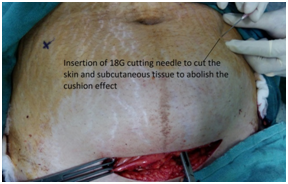Journal of
eISSN: 2373-6437


Short Communication Volume 5 Issue 5
1Post Graduate Department of Anaesthesia, Hi-Tech Medical College & Hospital, India
2Post Graduate Department of Surgery, Hi-Tech Medical College & Hospital, India
Correspondence: Ritesh Roy, Post Graduate department of Anaesthesia, Hi-Tech Medical College & Hospital, Bhubnaeswar-751007, Odisha, India
Received: July 27, 2016 | Published: August 30, 2016
Citation: Roy R, Pattnaik S (2016) Modified Surgeon Assisted Bilateral TAP Block - A New TAP Block Technique. J Anesth Crit Care Open Access 5(5): 00200. DOI: 10.15406/jaccoa.2016.05.00200
The transversus abdominis plane (TAP) block is a regional anesthesia technique which provides analgesia not only to parietal peritoneum but also to the skin and muscles of the anterior abdominal wall.1 It was first described by Rafi et al.2 after it has undergone several modifications as described by O’Donnell et al.3 and then by Hebbard et al.4 which have highlighted its potential utility for an increasing array of surgical procedures. TAP block has been underutilised inspite of having very low complication and high success rate using ultrasound technique. This may be due to the lack of availability of ultrasound at most of the centres, lack of training in ultrasound guided block technique or due to the fear of complications using the classical landmark approach.5,6 Although the block is technically straight forward, it is not much used in clinical practice and thus patients are deprived of adequate postoperative analgesia.
We describe a technique which can be used without the fear of complications in the blind landmark based approach. Our technique is as follows. Our landmark is at the level of umbilicus 8 to 10 cms from midline bilaterally (Figure 1). A tiny nick is made in the skin with a 18G sharp needle to obliterate the cushion effect (Figure 2). We then insert a 18 G Tuohy needle perpendicular to skin directing the needle slightly towards the ipsilateral anterior superior iliac spine just before the closure of peritonem. After feeling 2 pops of external and internal oblique aponeurosis the drug is injected after aspiration (Figure 4). Once the plane is reached the surgeon places his hand inside the abdominal cavity at the level of needle insertion to reconfirm needle placement (Figure 3). A bleb is palpated by the surgeon as the injection continues. The back flow of drug after injection is one of the signs that drug has been deposited in the TAP plane (Figure 5). The same procedure is repeated on the other side so a bilateral TAP block is performed.

Figure 2 Insertion of 18 G cutting needle to cut the skin and subcutaneous tissue to abolish the Cushion effect.
The advantage of this technique uses the surgeon hand as a guide. In obese and pregnant patients there are chances of missing the second pop due to thinning of the internal oblique aponeurosis. If one enters the peritoneal cavity accidentally the surgeon can guide to reposition your needle. Also there are nil chances of visceral injury. We have used this technique in more than 1000 cases of lower abdominal surgery for last 3 years with very good results. This technique being a open technique can be safely used by a beginner without any fear of complication which will help in providing good postoperative analgesia to maximum number of patients.
One of the concerns regarding this technique might be the chance of needle stick injury to the surgeon’s hand but since we used a blunt needle chances of injury is very less. We didn’t encounter a single incidence of needle stick injury in more than 1000 cases which we have done.
None.
The authors declare there is no conflict of interests.
None.

©2016 Roy, et al. This is an open access article distributed under the terms of the, which permits unrestricted use, distribution, and build upon your work non-commercially.